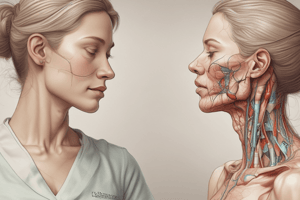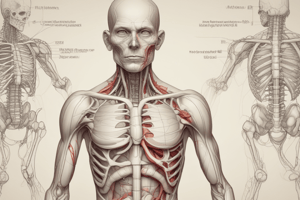Podcast
Questions and Answers
What is the primary reason for using proper body mechanics?
What is the primary reason for using proper body mechanics?
- To lift heavy objects easily
- To maintain patient confidentiality
- To complete tasks quickly
- To prevent injury to the patient and the Nurse Assistant (correct)
What is the purpose of a transfer belt when assisting a patient to ambulate?
What is the purpose of a transfer belt when assisting a patient to ambulate?
- To assist the patient in walking safely (correct)
- To lift the patient without straining
- To promote good body alignment
- To provide additional support to the patient's legs
What is the recommended position for a patient's head of bed when placed in a partial sitting position?
What is the recommended position for a patient's head of bed when placed in a partial sitting position?
- 0 degree angle
- 45 degree angle (correct)
- 90 degree angle
- 180 degree angle
What is the proper way to handle heavy objects?
What is the proper way to handle heavy objects?
Why is it important to explain the procedure to the patient or resident?
Why is it important to explain the procedure to the patient or resident?
What is the correct position of the Nurse Assistant when assisting a patient to ambulate?
What is the correct position of the Nurse Assistant when assisting a patient to ambulate?
What is the term for a patient positioned in bed with the head of the bed at a 45 degree angle?
What is the term for a patient positioned in bed with the head of the bed at a 45 degree angle?
What is the purpose of raising the bed to a working height?
What is the purpose of raising the bed to a working height?
What is a consequence of skin abrasion?
What is a consequence of skin abrasion?
When placing a patient in the lateral position, where should pillows be placed for support?
When placing a patient in the lateral position, where should pillows be placed for support?
What is the importance of proper body alignment when positioning a patient?
What is the importance of proper body alignment when positioning a patient?
What is the purpose of using pillows and/or foam pads?
What is the purpose of using pillows and/or foam pads?
Why is it important to use smooth movements when lifting or moving patients/residents?
Why is it important to use smooth movements when lifting or moving patients/residents?
What should the Nurse Assistant prioritize when assisting a patient to ambulate?
What should the Nurse Assistant prioritize when assisting a patient to ambulate?
What is the purpose of positioning the patient or resident in proper body alignment?
What is the purpose of positioning the patient or resident in proper body alignment?
Why is it important to inform the patient or resident of what you are doing and why?
Why is it important to inform the patient or resident of what you are doing and why?
What is the first step in the Mechanical Lift manual skill?
What is the first step in the Mechanical Lift manual skill?
What should be done to protect the patient/resident from injury during the Mechanical Lift?
What should be done to protect the patient/resident from injury during the Mechanical Lift?
What should the patient/resident do during the Mechanical Lift?
What should the patient/resident do during the Mechanical Lift?
What should be done with the lift after the patient/resident is centered over the wheelchair?
What should be done with the lift after the patient/resident is centered over the wheelchair?
Why should the hooks or straps be applied with open, sharp end facing away from the patient/resident?
Why should the hooks or straps be applied with open, sharp end facing away from the patient/resident?
What should be done before leaving the patient/resident's room?
What should be done before leaving the patient/resident's room?
What should be done after removing the gloves?
What should be done after removing the gloves?
What is the final step in the Mechanical Lift manual skill?
What is the final step in the Mechanical Lift manual skill?
What is the first step in assisting the patient/resident to ambulate with a walker or cane?
What is the first step in assisting the patient/resident to ambulate with a walker or cane?
Why is it important to knock and pause before entering the patient's/resident's room?
Why is it important to knock and pause before entering the patient's/resident's room?
What should you check on the walker or cane before using it?
What should you check on the walker or cane before using it?
Why should you stand in front of the patient/resident with your knees bent and feet apart?
Why should you stand in front of the patient/resident with your knees bent and feet apart?
What should you do with the transfer belt?
What should you do with the transfer belt?
Why should you identify the patient/resident?
Why should you identify the patient/resident?
What should you do with the patient's/resident's shoes or non-skid slippers?
What should you do with the patient's/resident's shoes or non-skid slippers?
Who should you report abnormal findings to?
Who should you report abnormal findings to?
What is the primary objective of Module 5: Body Mechanics?
What is the primary objective of Module 5: Body Mechanics?
What teaching strategy is used to review key terminology?
What teaching strategy is used to review key terminology?
What type of game is used to review key terminology?
What type of game is used to review key terminology?
What is the purpose of the vocabulary pre-test and post-test?
What is the purpose of the vocabulary pre-test and post-test?
What is the outcome of using the recommended teaching strategies?
What is the outcome of using the recommended teaching strategies?
What is the source of the accessed content?
What is the source of the accessed content?
When was the Nurse Assistant Model Curriculum revised?
When was the Nurse Assistant Model Curriculum revised?
What is the purpose of concentration game in the recommended teaching strategies?
What is the purpose of concentration game in the recommended teaching strategies?
Flashcards are hidden until you start studying
Study Notes
Body Mechanics
- Define key terminology related to body mechanics
- Use proper body mechanics to lift, turn, move, and position patients/residents in bed
- Avoid sudden jerky motions; use smooth movements
- Push, slide, or pull heavy objects instead of lifting
- Never twist your body, turn or pivot feet – face work
Comfort and Safety Measures
- Inform the patient/resident of what you are doing and why
- Provide privacy
- Raise bed to working height to promote safe body mechanics
- Use pillows and/or foam pads to support and cushion the patient/resident
- Position the patient/resident in proper body alignment
- Use proper body mechanics to move patient/resident up in bed with single or double assist
Legal and Total Quality Improvement (TQI) issues
- Protect and safeguard patient/resident
- Skin abrasion is a reason for citation and a reportable incident
- Back injuries refer to Work-related musculoskeletal disorder (WRMD)
- Patient/resident safety refers to OSHA
Mechanical Lift
- Wash hands
- Introduce self
- Identify patient/resident
- Explain procedure speaking clearly, slowly, and directly
- Gather equipment, if applicable
- Provide for privacy with a curtain, door, or screen
- Apply gloves (standard precautions)
- Secure co-worker to assist
- Position chair
- Position sling under the patient/resident
- Protect patient/resident from injury from metal bars/rings
- Position the lift over the patient/resident with the base beneath the bed and locked in its widest position
- Attach sling to mechanical lift with hooks or straps in place through the metal frame
- Inform patient/resident and staff members that lift is going to begin
Assisting the Patient/Resident to Ambulate
- Obtain information on patient’s/resident’s capabilities such as distance able to walk, type of assistive device, number of people, needs and weaknesses
- Wash hands
- Introduce self
- Identify patient/resident
- Explain procedure speaking clearly, slowly, and directly
- Gather equipment, if applicable
- Provide for privacy with a curtain, door, or screen
- Apply gloves (standard precautions)
- Lower bed to lowest position
- Place shoes or non-skid slippers on patient’s/resident’s feet
- Check walker or cane for worn or loose parts and appropriate height
- Place walker or cane close by the patient/resident
Studying That Suits You
Use AI to generate personalized quizzes and flashcards to suit your learning preferences.




